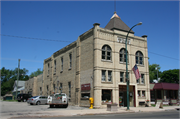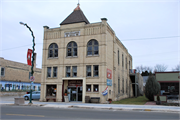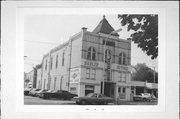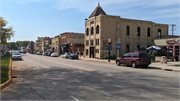Property Record
211 N MAIN ST
Architecture and History Inventory
| Historic Name: | ODD FELLOWS HALL/OPERA HOUSE |
|---|---|
| Other Name: | |
| Contributing: | Yes |
| Reference Number: | 6964 |
| Location (Address): | 211 N MAIN ST |
|---|---|
| County: | Jefferson |
| City: | Lake Mills |
| Township/Village: | |
| Unincorporated Community: | |
| Town: | |
| Range: | |
| Direction: | |
| Section: | |
| Quarter Section: | |
| Quarter/Quarter Section: |
| Year Built: | 1888 |
|---|---|
| Additions: | |
| Survey Date: | 197420142018 |
| Historic Use: | theater/opera house/concert hall |
| Architectural Style: | Romanesque Revival |
| Structural System: | |
| Wall Material: | Cream Brick |
| Architect: | |
| Other Buildings On Site: | |
| Demolished?: | No |
| Demolished Date: |
| National/State Register Listing Name: | Lake Mills Downtown Commercial Historic District |
|---|---|
| National Register Listing Date: | 4/5/2019 |
| State Register Listing Date: | 11/30/2018 |
| National Register Multiple Property Name: |
| Additional Information: | A 'site file' titled Lake Mills Downtown Commercial Historic District exists for this property. It contains additional information such as correspondence, newspaper clippings, or historical information. It is a public record and may be viewed in person at the Wisconsin Historical Society, Division of Historic Preservation-Public History. This three-story Romanesque Revival Style-influenced building was constructed in 1888 by Lake Mills builder Peter C. Henningson. The front (east) features a recessed center entry, a square storefront window, and small, paired, one-over-one, double-hung windows. The second story features three sets of paired, double-hung, one-over-one windows with brick lintels and stone sills. The third story features double-hung, one-over-one windows with stained-glass lunette windows, brick arches, and stone sills. Several brick stringcourses bisect the facade. Brick corbeling is featured along the cornice. “Odd Fellows 18 Hall 88” is inscribed along the cornice line. A hip projects from the center of the parapet. The side (north and south) elevations feature four-over-four, double-hung, sash windows with stone sills and brick arch lintels; brick buttresses; and brick corbelling along the cornice. The first floor of the building served as the Opera House, while the upper floors served as a meeting hall for the Odd Fellows. The building was sold in the late 1910s and remodeled as an automobile garage. It continued to operate as a garage/car dealership until the 1960s, when it was used as a farm implement store and later a community center. The building was purchased by its current owners in 1988 and converted into an antique store. A site visit in June 2014 confirmed the interior retains an open floor plan, wood floor, and wainscoting. In addition, the length of the building was extended to the rear by 20-feet in 1907. 1974-ROUND ARCHED WINDOWS IN 3RD FLR. BRICK WORK AND CORBELLING IN CORNICE. CENTRAL SLIGHTLY PROJECTING ENTRANCE TOWER W/PAVILION ROOF. |
|---|---|
| Bibliographic References: | Roland Liebenow. People, Their Places and Things: a Vignette History of Lake Mills, (Lake Mills, Wis.: N.p., n.d.), p. 130. “Main Street Messenger, Downtown Lake Mills”, brochure available at the Opera Hall. Wilson, Mary M. A History of Lake Mills: Creating a Society. Lake Mills, WI.: Self-Published, 1983, pp. 251-254, 326. Lake Mills Leader: January 24, 1899, p. 3; January 17, 1907, p. 1. |
| Wisconsin Architecture and History Inventory, State Historic Preservation Office, Wisconsin Historical Society, Madison, Wisconsin |





